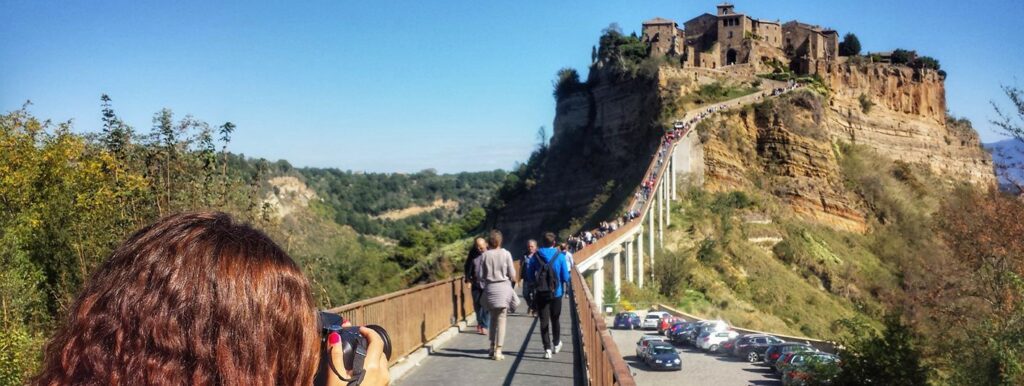
Civita di Bagnoregio![]() is a beautiful and fascinating medieval village in the province of Viterbo
is a beautiful and fascinating medieval village in the province of Viterbo![]() , not far from the border with Umbria, consisting of the more modern Bagnoregio and Civita the actual village. These are connected by a concrete footbridge about 600 metres long, which crosses the two deep ravines of the Rio Chiaro and Rio Torbido.
, not far from the border with Umbria, consisting of the more modern Bagnoregio and Civita the actual village. These are connected by a concrete footbridge about 600 metres long, which crosses the two deep ravines of the Rio Chiaro and Rio Torbido.
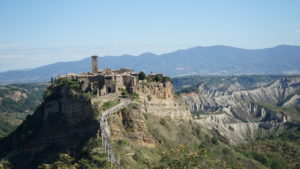 The position of the citadel is particularly suggestive in that it is perched on the summit of a remarkable hill, immersed in the silence of the surrounding tufa valley, as if frozen in time and space. It is precisely within this valley that the perennial erosion of the volcanic rock takes place, giving rise to the typical form of the calanchi (gullies), which makes the compactness of the village precarious.
The position of the citadel is particularly suggestive in that it is perched on the summit of a remarkable hill, immersed in the silence of the surrounding tufa valley, as if frozen in time and space. It is precisely within this valley that the perennial erosion of the volcanic rock takes place, giving rise to the typical form of the calanchi (gullies), which makes the compactness of the village precarious.
For this morphological reason, Civita is also known as ‘the dying town’ (an expression coined by the writer Bonaventura Tecchi), but although it has only 16 inhabitants as of 2011, it is, on the other hand, a destination for a considerable flow of tourists and has also been used several times as a film set, where Prince Antonio de Curtis aka Totò starred in the film The Two Colonels, General Contestation with Alberto Sordi, and Matteo Garrone’s Tale of Tales.
From the Belvedere of the Grotta di San Bonaventura![]() you can admire the reddish village of Civita, where the slender Romanesque bell tower of the church stands out.
you can admire the reddish village of Civita, where the slender Romanesque bell tower of the church stands out.
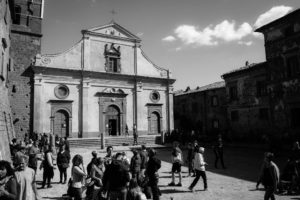
Access to the Borgo della Civita is chargeable (3.00 euro on weekdays, and 5.00 euro on holidays). Once you cross the bridge and pay the ‘toll’, you enter the Borgo through Porta Santa Maria![]() , where the main building, the Church of San Donato
, where the main building, the Church of San Donato![]() , stands in the nearby square. Built in the 16th century, it houses a 15th-century wooden crucifix from the school of Donatello, and a wonderful fresco by Perugino. At the base of the bell tower are two ancient Etruscan sarcophagi.
, stands in the nearby square. Built in the 16th century, it houses a 15th-century wooden crucifix from the school of Donatello, and a wonderful fresco by Perugino. At the base of the bell tower are two ancient Etruscan sarcophagi.
In the same Piazza San Donato in June, the Palio della Tonna takes place, a festival of medieval origin in which jockeys challenge each other in a daring ring race.
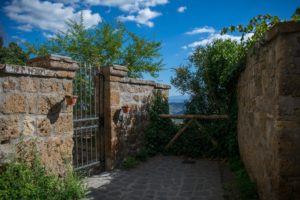
Strolling through this winding maze, full of narrow alleys overlooking the void, characterised by small arches, tree-lined courtyards, small squares and tree-lined courtyards, small squares, and ornate houses, where inside you will often find pretty craft shops, as well as tiny, typical restaurants where you can have lunch (or dinner), possibly booking well in advance given the large number of visitors.
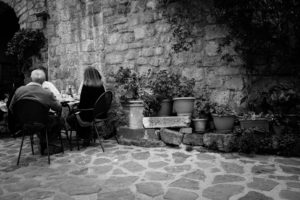
The ideal thing would be to visit the village during the three gastronomic evenings held every year during the ‘Profumi d’ Autunno’ (Autumn Fragrances) event, to discover the best autumn products of Tuscia (mushrooms, truffles, wild boar and chestnuts) and to take advantage of the opening of the cellars to taste some excellent ‘novello’ wine.
Photo Credits: ©Marinella Marruzzino, ©G.Miele/guidesmart
